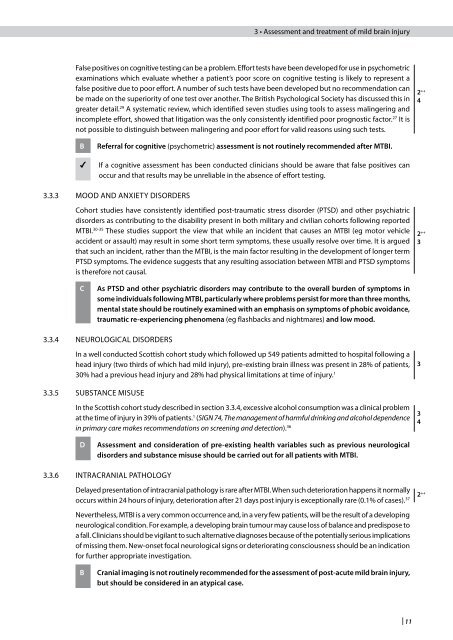sign130
sign130
sign130
You also want an ePaper? Increase the reach of your titles
YUMPU automatically turns print PDFs into web optimized ePapers that Google loves.
False positives on cognitive testing can be a problem. Effort tests have been developed for use in psychometric<br />
examinations which evaluate whether a patient’s poor score on cognitive testing is likely to represent a<br />
false positive due to poor effort. A number of such tests have been developed but no recommendation can<br />
be made on the superiority of one test over another. The British Psychological Society has discussed this in<br />
greater detail. 29 A systematic review, which identified seven studies using tools to assess malingering and<br />
incomplete effort, showed that litigation was the only consistently identified poor prognostic factor. 27 It is<br />
not possible to distinguish between malingering and poor effort for valid reasons using such tests.<br />
B Referral for cognitive (psychometric) assessment is not routinely recommended after MTBI.<br />
If a cognitive assessment has been conducted clinicians should be aware that false positives can<br />
occur and that results may be unreliable in the absence of effort testing.<br />
3.3.3 MOOD AND ANxIETy DISORDERS<br />
Cohort studies have consistently identified post-traumatic stress disorder (PTSD) and other psychiatric<br />
disorders as contributing to the disability present in both military and civilian cohorts following reported<br />
MTBI. 30-35 These studies support the view that while an incident that causes an MTBI (eg motor vehicle<br />
accident or assault) may result in some short term symptoms, these usually resolve over time. It is argued<br />
that such an incident, rather than the MTBI, is the main factor resulting in the development of longer term<br />
PTSD symptoms. The evidence suggests that any resulting association between MTBI and PTSD symptoms<br />
is therefore not causal.<br />
C As PTSD and other psychiatric disorders may contribute to the overall burden of symptoms in<br />
some individuals following MTBI, particularly where problems persist for more than three months,<br />
mental state should be routinely examined with an emphasis on symptoms of phobic avoidance,<br />
traumatic re-experiencing phenomena (eg flashbacks and nightmares) and low mood.<br />
3.3.4 NEUROLOGICAL DISORDERS<br />
In a well conducted Scottish cohort study which followed up 549 patients admitted to hospital following a<br />
head injury (two thirds of which had mild injury), pre-existing brain illness was present in 28% of patients,<br />
30% had a previous head injury and 28% had physical limitations at time of injury. 1<br />
3.3.5 SUBSTANCE MISUSE<br />
In the Scottish cohort study described in section 3.3.4, excessive alcohol consumption was a clinical problem<br />
at the time of injury in 39% of patients. 1 (SIGN 74, The management of harmful drinking and alcohol dependence<br />
in primary care makes recommendations on screening and detection). 36<br />
D Assessment and consideration of pre-existing health variables such as previous neurological<br />
disorders and substance misuse should be carried out for all patients with MTBI.<br />
3.3.6 INTRACRANIAL PATHOLOGy<br />
3 • Assessment and treatment of mild brain injury<br />
Delayed presentation of intracranial pathology is rare after MTBI. When such deterioration happens it normally<br />
occurs within 24 hours of injury, deterioration after 21 days post injury is exceptionally rare (0.1% of cases). 37<br />
Nevertheless, MTBI is a very common occurrence and, in a very few patients, will be the result of a developing<br />
neurological condition. For example, a developing brain tumour may cause loss of balance and predispose to<br />
a fall. Clinicians should be vigilant to such alternative diagnoses because of the potentially serious implications<br />
of missing them. New-onset focal neurological signs or deteriorating consciousness should be an indication<br />
for further appropriate investigation.<br />
B Cranial imaging is not routinely recommended for the assessment of post-acute mild brain injury,<br />
but should be considered in an atypical case.<br />
| 11<br />
2 ++<br />
4<br />
2 ++<br />
3<br />
3<br />
3<br />
4<br />
2 ++


